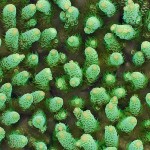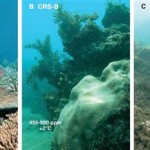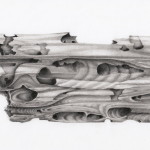![]() The global ocean has already taken up half of the atmospheric carbon dioxide produced by humans over the last 200 years, so the ongoing effects of climate change are dampened. That’s right, you can thank the ocean for saving the planet so far. Without the ocean, what we would have? A place that looks a lot like Mars.
The global ocean has already taken up half of the atmospheric carbon dioxide produced by humans over the last 200 years, so the ongoing effects of climate change are dampened. That’s right, you can thank the ocean for saving the planet so far. Without the ocean, what we would have? A place that looks a lot like Mars.
Ocean chemistry is changing, though, ever so slightly. The global ocean pH is about 8.2, slightly basic, but pH is falling (~0.1) due to an increased concentration of hydrogen ions resulting from the chemical reaction of water molecules and carbon dioxide at the ocean surface. Ocean pH is expected to fall even more, between 0.3 and 0.4 by the year 2100, if we continue burning fossil fuels at current rates. Note the values are still basic, so the oceans are not really “turning to acid”, but the change in pH could have important consequences for ocean animals.
Many ocean animals use calcium carbonate in their skeletons including corals, mollusks, and crustaceans. Single celled algae like the coccolithopores also have calcified plates. Will they adapt? During the Paleocene-Eocene thermal maximum many benthic calcifiers went extinct.
A recent paper in Coral Reefs by Turley et al (2007) anticipates that many species will not escape the effects of climate change, and even the deep reef forming corals will be in jeopardy from increasing atmospheric CO2. This perspective piece calls attention to the problem, but no new data is provided. Instead there is a call for information exchange and collaboration between warm water coral scientists and cold water coral scientists. Few could dispute the value of this exchange.
To be fair, caveats to the argument that pH is changing faster than corals can adapt might include the long fossil record of the Anthozoa, the phylogeny of the Cnidaria, the existence and survival of scleractinian forms below the carbonate compensation depth, and contrasting aquarium experiments that show these animals can be either 1) doomed to dissolution or 2) remarkably adaptable. What’s your guess?
Tune in to Coral Week this April for five full days on deep-sea corals, and more on this controversy.
Reference:
Turley, CM, JM Roberts, JM Guinotte. 2007. Corals in deep-water: will the unseen hand of ocean acidification destroy cold-water ecosystems? Coral Reefs 26:445-448. doi 10.1007/s00338-007-0247-5






I tend to think that corals are a lot more resilient than we give them credit for. Aquariums are certainly anecdotal evidence of this, as any coral I have ever kept (all fragged from other aquarium specimens, not directly wild collected) would have been dead within days of reaching my tanks if they needed such stringent conditions. Typical home aquariums can experience pH swings of more than .1 DAILY, and even experienced aquarists keep their more fragile corals at pH’s anywhere from 8.1 to 8.5. That being said, I think much more direct threats to corals are overfishing and invasive species, both of which we SHOULD be more than capable of dealing with but apparently refuse to do…
With regards to ocean acidification, I think I remember learning that coccolithophores would be the first major group of organisms directly affected by it because they require the highest pH of the major calcifying organisms in the ocean. As the pH drops they die off first, but that means that a significant percentage of the calcification reactions in the ocean stop (or slow), which in turn means the acidification slows. So while it sucks to be a coccolithophore, they do serve as a first line of defense. Of course this could also cause a huge problem in terms of food chain dynamics, among other things, so it’s still a bad thing for more than just the coccolithophores…
http://scienceblogs.com/deepseanews/2007/08/experiments_in_ocean_acidifica_1.php
Max, the DSN story above links to an abstract of a lab experiment that found negligible changes to coccolithphore size and mass under conditions of reduced pH.
Ok, I’ll expose my complete inability to remember specifics here, or to find the appropriate references with anything other than PubMed (I work in HIV research), but I remember seeing images of coccolithophores grown at lower pH that only a mother would be able to love. It wasn’t that they didn’t grow, but rather that they were unable to produce coccoliths appropriately. I saw these in a class I took on phytoplankton in late 2005/early 2006 and it was a recent paper at the time. I did find an abstract now about coccolithophore production decoupled from pH, which shows species are differentially affected by using different forms of carbon, but what caught my eye was one sentence where they said:
“Despite the intracellular nature of coccolithophore calcification, previous experimental work confirmed that some (but not all) modern coccolithophores decrease calcification as pCO2 increases.”
The abstract is at http://www.cosis.net/abstracts/EGU2008/08750/EGU2008-A-08750.pdf
As a side note, how do you usually search for references? I have full access to pretty much everything at the university I work at, but I’m not a big fan of their library web site…
Never used PubMed, myself, though I come across it quite a bit. I like online databases like Web of Science, Cambridge Scientific Abstracts, Aquatic Fisheries and Sciences Abstracts, and ScienceDirect for my research, coupled with a more analog search of references in my favorite papers.
My question regarding the effects of acidification on corals, mussels, oysters, etc isn’t so much the effects on their skeletons/structures per se. While extreme changes could well have big effects, I think the more immediate problem will be food. If acidification effects the resource base these filter feeders are drawing on, then even if they have a mechanism of compensation, they may well not have the energy to compensate, nor will they even be deriving enough nutriment to generate these expensive structures.
Max – The paper you are looking for is Riebesell et al. 2000. I think you might need a subscription to nature to see the deformed coccolithiphore photos.